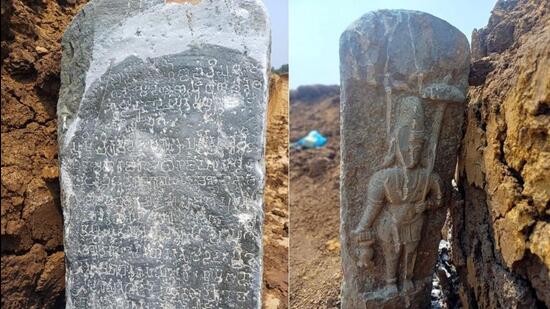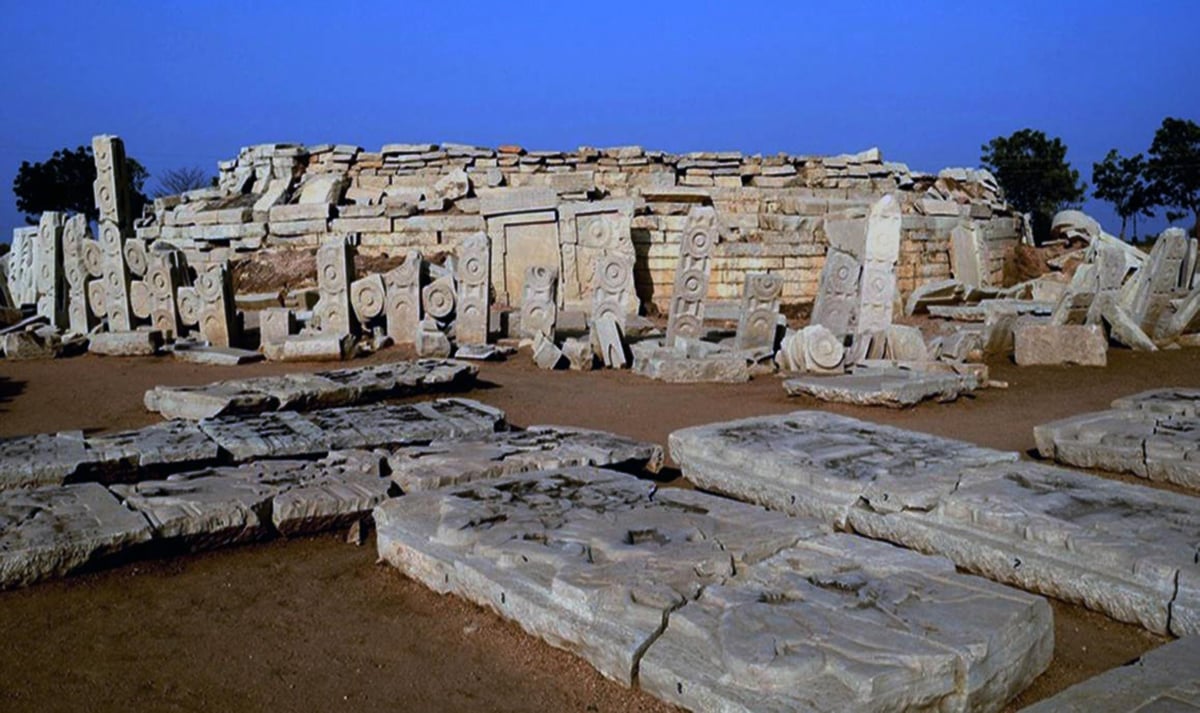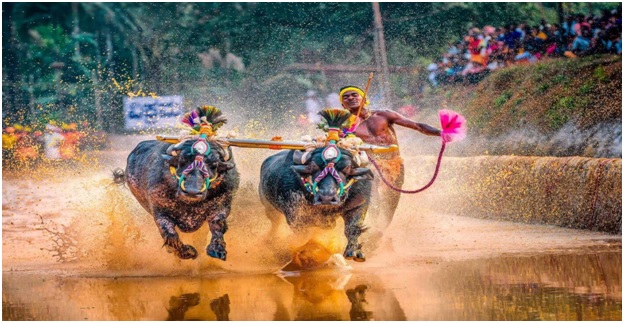Rare 7th-Century Old Kannada Inscription unearthed at Madapura Lake, Karnataka

- 07 May 2025
In News:
A rare 7th-century Old Kannada inscription from the reign of Vikramaditya I of the Badami Chalukyas has been discovered at Madapura Lake in Davangere, Karnataka. The inscription sheds light on taxation, land grants, and regional governance during his rule.
About the Badami Chalukyas
- Origins: Emerged as a regional Kannada power claiming descent from Ayodhya to establish legitimacy.
- Capital:Vatapi (present-day Badami, Karnataka).
- Notable Rulers and Political History:
- Pulakesin I (543–566 CE): Founder of the dynasty; fortified Badami.
- Pulakesin II (609–642 CE): Most celebrated ruler; defeated Harshavardhana at the Narmada river; established diplomatic contacts with Persia (depicted in Ajanta caves).
- Vikramaditya I (644–681 CE): Son of Pulakesin II; reclaimed Badami from Pallavas and expanded influence over southern kingdoms like the Cholas, Pandyas, and Keralas.
- Administration:
- Centralised monarchy with limited autonomy granted to villages.
- Economy relied on land revenue and military conquests.
- Maintained a naval fleet—Pulakesin II had around 100 ships.
- Religion:Patronised Shaivism, Vaishnavism, Shaktism, and Jainism. Vikramaditya I and others made donations to Jain institutions; Pulakesin I performed Ashvamedha Yajna.
- Art and Architecture:
- Developed the Vesara style, a fusion of northern Nagara and southern Dravida temple architecture.
- Constructed rock-cut and structural temples in Aihole, Badami, and Pattadakal.
About Vikramaditya I
- Background: Son of Pulakesin II; ascended the throne during a period of political turmoil following his father's death and Pallava invasion.
- Military Achievements:
- Defeated Narasimhavarman I of the Pallavas, who had earlier seized Badami.
- Reunited the fractured Chalukya empire, restoring its former prestige.
- Subdued southern powers including the Cholas, Pandyas, and Keralas, consolidating control over the southern Deccan.
- Political Consolidation:
- Re-established central authority across Karnataka and surrounding regions.
- Appointed loyal feudatories, such as Singhavenna (mentioned in the new Davangere inscription), to manage local governance.
- Legacy:
- Known by titles such as Rajamalla (King of Kings) and Yuddhamalla (Warrior King).
- His reign marked a revival of Chalukya power and paved the way for cultural and architectural achievements under his successors Vikramaditya II and Kirtivarman II.
Sannati: Ancient Buddhist Site

- 05 Apr 2024
Why is it in the News?
Left neglected for many years after it came to light through the ASI excavations in the 1990s, the ancient Buddhist site of Sannati on the bank of the Bhima River got a restoration project in 2022.
About Ancient Sannati Buddhist site:
- This ancient Sannati Buddhist site, situated alongside the Bhima River near Kanaganahalli in Karnataka's Kalaburagi district, offers a rich historical and cultural experience.
- Notably, it also boasts the Chandrala Parameshwari Temple, a popular attraction among tourists.
Key discoveries at this site include evidence of development across three distinct phases:
- Maurya, Early Satavahana, and Later Satavahana periods, span from the 3rd Century B.C. to the 3rd Century A.D.
- The Ranamandala area of Sannati presents a unique chronological timeline from prehistoric to early historic eras.
- Among the remarkable findings is an inscription in the Prakrit language, inscribed using Brahmi script.
- Noteworthy is the recovery of a significant stone sculpture portraying Mauryan Emperor Ashoka, surrounded by his queens and attendants, with the inscription "Raya Asoko" in Brahmi script, leaving no doubt about the identity of the depicted figure.
- The excavation also yielded around 60 dome slabs featuring sculptural depictions of Jataka stories, significant events in the life of Buddha, portraits of Shatavahana monarchs, and unique representations of Buddhist missionaries dispatched by Ashoka to various regions.
- Moreover, the ancient Nagavi Ghatikasthana, often dubbed as the Takshashila of the South, lies approximately 40 km from Sannati.
- Functioning as a prominent educational center akin to a modern-day university during the Rashtrakuta and Kalyana Chalukya dynasties from the 10th to 12th Centuries, it held great historical significance.
NAL Successfully Tested High Altitude Pseudo-Satellite (HAPS) at Challakere, Karnataka (TOI)

- 12 Feb 2024
Why is it in the News?
Scientists from city-based National Aerospace Laboratories (NAL), a Council of Scientific and Industrial Research (CSIR) lab, achieved a breakthrough by successfully testing an unmanned aerial vehicle called High-Altitude Pseudo Satellite (HAPS) at Chitradurga's Challakere in Karnataka.
News Summary:
- National Aerospace Laboratories (NAL) has achieved a milestone with the successful testing of an unmanned aerial vehicle known as the High Altitude Pseudo-Satellite (HAPS) in Challakere, Karnataka.
- This innovative system, measuring 5 meters in length with an impressive 11-meter wingspan and weighing 23 kg, soared to an altitude of approximately 3 km and maintained its position for an impressive duration of eight hours.
- A comprehensive series of tests is slated, with the ultimate goal of developing a full-fledged aircraft boasting a remarkable 30-meter wingspan comparable to a Boeing 737 by the year 2027.
- This advanced craft is anticipated to ascend to an impressive altitude of 23 km and remain airborne for a remarkable period of at least 90 days.
- NAL's ambitious agenda includes the design and construction of various components essential for the HAPS, including propellers, battery management systems, carbon-composite airframes, flight-control systems, and high-powered electric motors capable of withstanding extreme temperature variations.
- Additionally, in a separate endeavour, a Bengaluru-based private company recently conducted the inaugural test flight of a solar-powered, long-endurance drone, achieving an impressive flight duration of 21 hours.
About High Altitude Pseudo-Satellite (HAPS):
- Since the 1990s, numerous global initiatives have been undertaken to explore the potential applications of High Altitude Pseudo Satellites, also known as High Altitude Platform Stations (HAPS).
- Positioned above 20 km altitude in the stratosphere, these unmanned aircraft are designed for exceptionally long-duration flights, spanning months or even years.
- HAPS encompass various aircraft types, including airplanes, airships, and balloons.
Benefits/Advantages of HAPS:
- These solar-powered vehicles bridge the gap between unmanned aerial vehicles (UAVs) operating in lower altitudes and traditional satellites in space.
- They offer a wide array of applications, including telecommunications, emergency/public safety communications, intelligent transportation systems, maritime surveillance, environmental monitoring, and land border control.
- Compared to ground-based communication networks, HAPS can cover larger areas with minimal interference and facilitate data transfer between satellites and ground-based telecom networks.
- Unlike traditional satellites, which are costly to construct and launch, HAPS are more cost-effective and easier to deploy.
- It has both military and civilian applications, including intelligence, surveillance, telecommunication, and disaster response.
- The technology offers lower latency and can connect to multiple ground stations.
Significance for India:
- In India, Hindustan Aeronautics Limited (HAL) announced in 2022 its collaboration with a startup company to develop a "futuristic" high-altitude pseudo satellite.
- Given India's extensive land borders stretching approximately 15,000 km and a coastline spanning 7,500 km, securing these borders is paramount, necessitating diverse solutions.
- Hovering at the Earth's atmospheric edge, HAPS offer valuable services for efficient border surveillance, tracking enemy movements deep into territories or seas, and conducting round-the-clock missions.
- Equipped with advanced optical and infrared cameras, state-of-the-art sensors, and other sophisticated technology, these aerial platforms are ideal for border patrolling, target tracking, maritime surveillance, navigation, and even missile detection.
- China's Aviation Industry Corporation of China (AVIC), a state-owned aerospace and defense conglomerate, has been actively developing various HAPS platforms for surveillance purposes.
- In 2018, it successfully tested the solar-powered Morning Star drone, renowned for its prolonged airborne endurance.
Kambala (Indian Express)

- 27 Nov 2023
Why is it in the News?
On the weekend of November 25 and 26, 160 pairs of buffaloes and their jockeys will race on specially made slush tracks for Kambala races at City Palace Grounds in Bengaluru.
What is Kambala?
- Kambala is a folk sport rooted in coastal Karnataka, particularly in areas where Tulu speakers are predominant.
- In the past, families and groups used to organize races in the muddy paddy fields after the harvest season.
- For many families, especially those from the Bunt community in coastal regions, Kambala holds significant prestige.
- Throughout the year, they groom pairs of buffaloes with the aim of winning major Kambala events and other races.
Kambala consists of four main categories:
- Negilu (plough): Lighter ploughs are used to tie buffaloes for the race.
- This category is for entry-level buffalo pairs participating in their first Kambala race.
- Hagga (rope): Buffaloes are raced by jockeys with just a rope tied to both buffaloes.
- Adda Halage: Participants stand over a horizontal plank dragged by buffaloes.
- Unlike Hagga and Negilu, where jockeys run behind the animals, buffaloes drag the jockeys in Adda Halage.
- Kane Halage: A wooden plank is tied to buffaloes.
- The plank, on which jockeys stand, has two holes through which water gushes out as it is dragged along the slush tracks.
- The height of water splashes determines the winner of the event.
